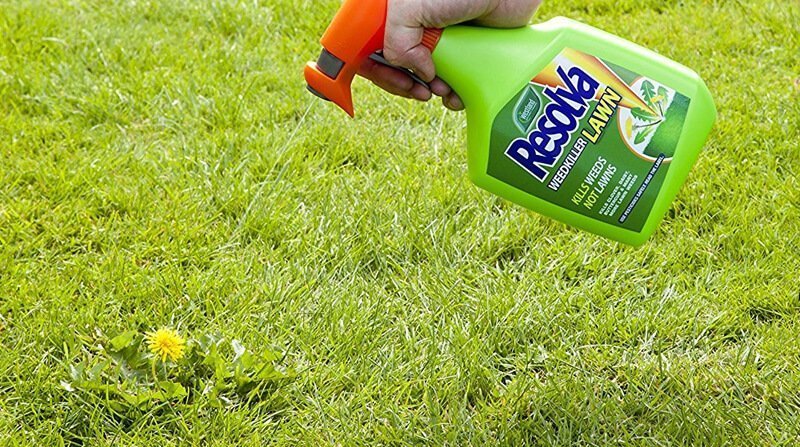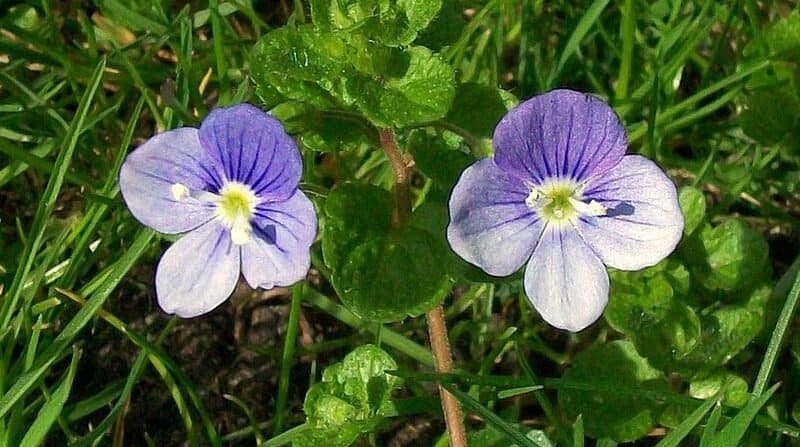Speedwell is a weed that inhabits lawns all across the UK. They bloom very pretty blue flowers.
There are several different types of Speedwell but only two of them cause problems in lawns. They are Germander Speedwell and Slender Speedwell.
Up until recently it was killed or controlled with a selective weedkiller called Ioxnil but this chemical was banned in 2015. As a result, Speedwell can be a real pain to completely get rid of.
But with the right approach and a bit of patience, you can remove Speedwell and prevent it from growing back.
Speedwell in a Nutshell
Like I said, there are two species of Speedwell that inhabit UK lawns;
-
- Slender Speedwell, and
- Germander Speedwell
Each one has different characteristics which we’ll look at.
Slender Speedwell

Slender Speedwell or Veronica Filiformis has a few names, including;
- Creeping Speedwell
- Threadstalk Speedwell and
- Whetzel Weed
Whatever you call it, it was introduced into the UK from Turkey in 1808 as a rock garden plant and soon started creeping into lawns.
It has small, hairy leaves that start off kidney shaped with ruffled edges but become more rounded as they mature.
The flowers, which are visible between April and June are very pretty. They have four blue/purple petals, one of which is always smaller than the other three.
It grows on slender stems which root at intervals which means it can cover large areas.
Unlike other species of Speedwell, Slender Speedwell spreads not by seed, but by bits of stem which gets scattered by mowing.
Germander Speedwell

Another one of the Speedwell species, Germander Speedwell, or Veronica Chamaedrys goes by a few names including ‘Cats Eye’ and ‘Birds Eye’.
Germander Speedwell mostly grows low to the ground but if left to get out of hand, can grow to 50cm tall on hairy stems.
The leaves are in opposite pairs, have prominent veins and heavily toothed edges.
Its flowers, which bloom between April and June, are deep blue and have four petals, one of which is significantly smaller than the other three. The centre of the flower is white and this is where the names ‘Cats Eye’ and ‘Birds Eye’ come from.
Like Slender Speedwell, it grows on slender stems which root at intervals to grow new plants so it can cover a large area.
A Perennial Weed
Speedwell is a perennial weed, meaning that it grows back year after year if not dealt with.
The leaves may fall off during the Summer leading you to believe the plant has died. But make no mistake, the roots will stay put, ready to grow again next year.
Preferred Habitat
You’ll find Speedwell in all types of soil but it loves moist, nutrient-rich soil that can tolerate close mowing.
How to Remove Speedwell From Your Lawn
As I said at the beginning of this article, Speedwell can be horrible to remove and it might take you a few attempts to completely get rid of it.
Here’s how;
Remove it by Hand
Remove any weeds by hand as soon as you see them. It grows close to the ground so give your grass a cut so you can see what you’re doing.
This weed can grow back from fragments of root chopped up by your lawnmower so make sure you keep the grass collection box on to collect any debris.
If you’ve only got one or two weeds in your lawn the best approach is to remove them by hand. Rake over the area, pulling at the roots and runners with the tines. This will make it easier to get a hold of them. Also, use a hand fork to pull the runners out from under the surface.
Take your time to remove the whole thing and not leave any fragments of root in the soil.
If this doesn’t work and the Speedwell grows back, consider cutting out the infected turf and re-turf the area, or…
Try Killing it with a Spot Spray Weedkiller

Speedwell used to be controlled by a chemical called Ioxynil which is no longer available.
The next best weedkiller to use these days is one that contains ‘Fluroxypyr’ such as Resolva Lawn Weedkiller Spot Spray.
However, it’ll probably need more than one application to kill it.
- Small spray bottle ideal for small areas
- Non-glyphosate formulation
Spray the Whole Lawn With a Selective Weedkiller Concentrate
If you have a lot of Speedwell in your lawn as well as other weeds, spot treatment won’t be enough. You’ll need to spray the whole lawn with a selective weedkiller concentrate.
Again, you’ll need a product that contains Fluroxypyr, so try Weedol Lawn Weedkiller Concentrate. It is designed to be diluted in water and applied via a knapsack sprayer or watering can.
- Apply through a sprayer or watering can
- Non-glyphosate formulation
When using a weedkiller concentrate, you need to mix it accurately as per the manufacturer’s instructions.
Mix it too weak and it won’t kill Speedwell. You might be tempted to make it stronger but if you do, you risk killing the grass too.
Read: Which is the Best Weedkiller for Grass? My Top Picks
Hire a Professional
Sometimes amateur pesticides might not kill Speedwell in which case you might need to hire a lawn care expert. They should be certified to use and have access to professional pesticides that amateur gardeners aren’t allowed to use.
How to Prevent Speedwell From Growing in Your Lawn
Because Speedwell can be so difficult to get rid of, you’ll definitely want to prevent it from growing back.
A dense, healthy lawn will choke out Speedwell and not give it the room to grow. You do this with good lawn care practices that promote good grass growth.
Make sure you;
Mow the Lawn on a Regular Basis

Mowing the lawn regularly is the single most important aspect of maintaining a healthy lawn.
It’s also the most overlooked.
Healthy grass has to grow, and if it can’t grow tall it has to grow in other ways. Cutting the grass prevents it from growing upwards so it is forced to grow sideways, creating new shoots and new grass leaves. This sideways growth is what creates a thick, lush lawn.
If you allow the grass to grow tall and then hack it down after 8 weeks, you take away all its water and food supply. You’ll shock it, even kill it, ending up with a lawn with sparse, patchy brown grass. An environment that weeds and moss thrive in.
Cut the grass at least every 10 days between April and September.
Read: How to Mow the Lawn Like a Pro: Everything You Should Know About Grass Cutting
Remove Excess Thatch by Scarifying Your Lawn

Thatch is a fibrous layer of organic material that lies on top of the soil and in amongst the crowns of the grass plant.
It’s made up of old both living and dead grass shoots, old clippings and other stuff.
Some lawn thatch is a good thing at it protects the crown of the grass plant from damage and disease.
Too much, on the other hand, prevents water, air and nutrients from penetrating the soil, starving the grass of what it needs to be able to produce food and grow. This results in a threadbare lawn with weak, unhealthy grass.
Lawn scarification is a process of ripping the excess thatch out of a lawn with a machine called a Scarifier. It’ll look rough for a week or two but with the right recovery program your lawn will recover, be full of grass and take away the room for Creeping Speedwell or Germander Speedwell to grow in.
And it’ll look better than ever.
Read: Lawn Scarification: Why, When and How to Scarify Your Lawn (The Ultimate Guide)
Aerate Your Lawn to Relieve Soil Compaction

Soil compaction occurs when you use a lawn heavily. This could be kids spending the summer playing on it or certain areas being used regularly, like the washing line or the route the postman takes over your lawn to get to the letterbox.
However it happens, the activity on the lawn pushes the soil particles under the surface, closer and closer together. This squeezes out water and air while at the same time, making the ground harder.
This does two things;
- It starves the grass of the nutrients it needs to produce food and grow, and
- It makes it hard for the roots to grow because the ground is so hard.
Aerating the lawn involves spiking it (usually during the spring) and/or removing cores of turf via hollow tining (usually every couple of years during the autumn).
Aerating creates holes that are usually 2-3inches deep in the surface of the soil. These holes allow water, air and nutrients to work their way into the soil to the root zone of the grass. The grass can then consume these nutrients, produce food and grow strong, resulting in a lawn full of healthy grass with no room for Slender Speedwell to grow in.
Read: Lawn Aeration: Everything You Need to Know About Aerating Your Lawn (The Ultimate Guide)
Fertilise Your Lawn

Just because Speedwell loves fertile soil doesn’t mean you should avoid fertilising your lawn.
Grass grows best in soil that is rich in Nitrogen, Potassium and Phosphorous.
Remember, the best way to prevent weeds from growing is to create the best conditions as possible for grass growth. This leaves no room for weeds to germinate.
So fertilise your lawn.
There are lots of fertilisers on the market that are designed to be applied at different times of the year, as well as weed and feed products.
At the very least, apply a good quality, slow release fertiliser once a year to keep the soil’s nutrients topped up.
Your grass will thank you for it.
Read: Lawn Fertiliser: What, Why, When and How to Feed Your Lawn
Also Read: Which is The Best Lawn Fertiliser: My Top Picks
In Conclusion
Speedwell is a pain in the lawn!
It’s not the most common lawn weed. Definitely not as common as Dandelion type weeds, Daisies or White Clover but it if starts to inhabit your lawn, it can be a real pain to remove.
If you’ve only got one or two plants, try hand weeding, you might get lucky and remove it at the first attempt. Try hitting them with a weedkiller like Resolva Spot Spray or Weedkiller Concentrate if they come back.
If that doesn’t work, hire a professional lawn care expert. They’re allowed to use chemicals that amateur gardeners aren’t.
But as I always say, the removal of weeds is less than half the battle. Regular, good lawn care practices will prevent them from growing back, or even growing in the first place.



